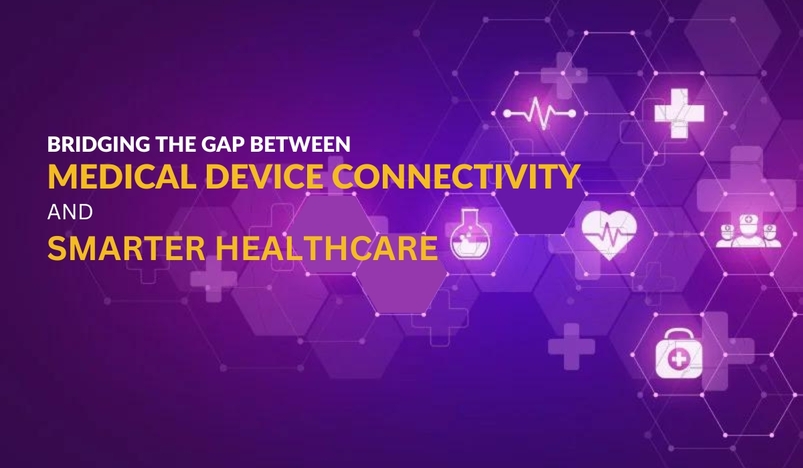
Medical Device Connectivity and Smarter Healthcare
In today’s fast changing world, with technological advancements in every sector, healthcare providers are combining a variety of digital services to give patients a better and well-rounded healthcare experience. The pandemic has further accelerated global healthcare service digitization all around the world, with this undoubtedly improving healthcare access, quality, and overall patient experience.
So how are medical equipment and healthcare services keeping up in today’s continually developing world? In this article, we shall examine the advancements in the digitalization of medical equipment and the evolution of technology in the medical industry.
Enhancing features, functionality, and accessibility and ultimately improving patient care is what drives medical equipment producers to better their technology. A greater potential for monitoring, alerting, gathering and analyzing medical data, managing drug doses, and even assisting surgeons is made possible by the integration of communications technology into medical devices.
The Medical sector in Qatar is continually evolving with the technological innovations in the field and is involved in a range of projects that aim to introduce the country to the latest healthcare technologies. Some examples of these technologies include Artificial Intelligence, Stem Cell Therapy, Mobile Health and Telemedicine.
However, while greater patient care is undoubtedly made possible with the incorporation of computer components and other medical technology, it also exposes medical equipment to the same cybersecurity risks inherent for other conventional information systems. Manufacturers and medical institutions without a proper procedure in place to manage cybersecurity risks during periods of change, have been particularly vulnerable as industries transition into digitalization. Manufacturers of medical devices are exposed to a wider range of cyber threats over time as they add additional functionality through networking and digitalization.
Worldwide adoption and advancement in technology in the medical field:
• E-healthcare
The availability of remote clinical services like video consultations, improved patient access and convenience, and increased disease management awareness are all made possible through telemedicine.
• Analytical Data
Timely analysis and thorough study of patient data is essential for the early detection of health issues and subsequent care planning and coordination to address specific patient needs. Mobile health applications, including wellness and fitness apps, keep track of crucial data for managing ailments and diseases helping to support positive behaviors and the adoption of healthy patterns. The digitized healthcare systems in use today, such as Electronic Medical Records (EMR) and Electronic Health Records (EHR), store and exchange data for integrated care models.
• Robotics
A wide range of tasks, including assisted surgeries and patient support, are made easier with the integration of robotic technology into medical equipment and services. Robotics improves surgical precision, hastening patient recovery and reducing length of stay at the hospital.
In Qatar, the Primary Health Care Corporation and the Hamad Medical Corporation have teamed up with Cerner to provide remote virtual consultations to patients. Additionally, The Hamad Medical Corporation’s Child Development Centre has begun offering online consultations.
One of the many ways the government of Qatar plans on improving its digital growth is by starting the Qatar Smart Program (TASMU)- designed specifically to accelerate the achievement of all the pillars of the Qatar National Vision 2030. A budget of QR 6 billion has also been allotted for the development of the required technological infrastructure and to activate hundreds of initiatives across many sectors. In order to expand the population's access to high-quality affordable healthcare, and lower the risk of chronic illness, the Tasmu Smart Qatar Program has identified the healthcare sector as a major area for investment. Remote Patient Monitoring, Digital Support Groups, VR First Aid, ICE Tracking and Response, Digital Nurse, myHealth Gateway, Digital Health Coach and Smart Medication are some of the many initiatives under the program.
Other organizations like the Qatar Biobank also gather and examine biological samples to aid in the treatment and prevention of disease through new technological methods. The National Centre for Cancer Care and Research and the Heart National Hospital, both of which are a part of the Hamad Medical Corporation, use Cerner's EHR technology. The government of Qatar understands the importance of public health in supporting its development goals and recognises also the contribution that digitalization and modernisation can make to this.
.jpg)
Qatar Secures Place Among the World's Top 10 Wealthiest Nations
.jpg)
Hamad International Airport Witnesses Record Increase in Passenger Traffic

Saudi Arabia: Any visa holder can now perform Umrah

What are Qatar's Labour Laws on Annual Leave?
Leave a comment